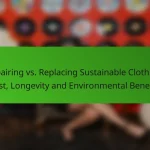When considering sustainable clothing, the choice between repairing and replacing hinges on cost, longevity, and environmental benefits. Repairing garments not only extends their lifespan but also significantly reduces waste and conserves resources, making it an eco-friendly option. However, in some instances, replacing clothing may be necessary, especially when new sustainable options offer improved durability and advanced materials.

Should I repair or replace sustainable clothing in the UK?
In the UK, deciding whether to repair or replace sustainable clothing depends on factors like cost, longevity, and environmental impact. Generally, repairing can be more economical and eco-friendly, but replacement may be necessary in some cases.
Cost-effectiveness of repairs
Repairing sustainable clothing often proves to be more cost-effective than replacing it. Simple fixes, such as sewing a seam or replacing a button, can typically cost less than £10, while professional repairs may range from £15 to £50 depending on the complexity.
Consider the age and condition of the garment; if the repair cost is significantly lower than the price of a new, similar item, it’s usually worth fixing. Additionally, many local tailors and alteration services offer competitive rates, making repairs accessible.
Benefits of replacement
Replacing clothing can sometimes be the better option, especially if the garment is heavily worn or outdated. New sustainable clothing often incorporates advanced materials and technologies that enhance durability and comfort, which may not be possible to achieve through repairs.
Moreover, if a garment no longer fits or aligns with your style, investing in a new piece can be more satisfying. When selecting replacements, look for brands that prioritize sustainability to maintain your commitment to eco-friendly practices.
Consumer preferences in the UK
In the UK, consumer preferences are increasingly leaning towards sustainability, with many individuals valuing repairs over replacements. Surveys indicate that a significant portion of shoppers are willing to invest in repair services to extend the life of their clothing.
However, convenience often drives the decision to replace. Busy lifestyles can lead consumers to choose new items for immediate needs rather than seeking out repair options. Awareness campaigns promoting the benefits of repairing clothing are essential to shift this trend further towards sustainability.

What are the environmental benefits of repairing sustainable clothing?
Repairing sustainable clothing significantly reduces environmental impact by extending the lifespan of garments and minimizing waste. This practice conserves resources and lowers the overall carbon footprint associated with clothing production.
Reduction in textile waste
Repairing clothing helps to keep textiles out of landfills, where they can take years to decompose. By mending rather than discarding, you contribute to a circular economy that prioritizes reuse and sustainability.
For instance, a single repaired garment can prevent several kilograms of textile waste from being generated. Many communities now offer repair workshops, making it easier for individuals to learn skills that prolong the life of their clothing.
Lower carbon footprint
The carbon footprint of clothing production is substantial, often involving high energy consumption and greenhouse gas emissions. By opting to repair rather than replace, you help reduce the demand for new garments, which in turn lowers emissions associated with manufacturing and transportation.
Repairing clothes can save approximately 50-70% of the carbon emissions that would result from producing a new item. Simple repairs, such as sewing a seam or replacing a button, can significantly impact your overall environmental footprint.

How does longevity compare between repaired and replaced clothing?
Repaired clothing can often last longer than replaced items, depending on the quality of the repair and the original garment. While repairs can extend the life of a piece, new sustainable clothing may offer enhanced durability due to advanced materials and construction techniques.
Average lifespan of repaired items
The average lifespan of repaired clothing can vary widely, typically extending the life of a garment by several months to a few years. For example, a well-repaired pair of jeans might last an additional 1-3 years, depending on the extent of wear and the quality of the repair. Regular maintenance and care can further enhance longevity.
Common repairs include patching holes, reinforcing seams, and replacing zippers. Each of these can significantly improve the usability of the item, making it a sustainable choice for consumers looking to reduce waste.
Durability of new sustainable clothing
New sustainable clothing is often designed with durability in mind, using high-quality materials that can withstand wear and tear. Many brands focus on creating garments that last longer than traditional fast fashion, with lifespans often exceeding 3-5 years under regular use. This is achieved through better stitching, robust fabrics, and eco-friendly treatments.
When choosing new sustainable clothing, look for certifications such as GOTS (Global Organic Textile Standard) or OEKO-TEX, which indicate adherence to strict durability and environmental standards. Investing in these items can lead to savings over time, as they may require fewer replacements.

What are the costs associated with repairing vs. replacing clothing?
The costs of repairing versus replacing clothing can vary significantly based on the type of garment, the extent of damage, and the materials involved. Generally, repairs tend to be less expensive than purchasing new sustainable clothing, but the decision should also factor in longevity and environmental impact.
Typical repair costs
Repair costs can range from low tens of dollars for minor fixes, like sewing a button or patching a small hole, to higher amounts for more complex repairs, such as re-stitching seams or replacing zippers. Many local tailors or alteration shops offer services that can help extend the life of your clothing at reasonable prices.
For example, a simple hem might cost around $10 to $20, while more intricate repairs could reach $50 or more. It’s often worth comparing repair costs to the price of new garments to determine the most economical option.
Average costs of new sustainable clothing
The average cost of new sustainable clothing typically ranges from $50 to $200, depending on the brand, materials, and production practices. High-quality sustainable brands often emphasize ethical sourcing and environmentally friendly materials, which can contribute to higher price points compared to fast fashion alternatives.
For instance, a sustainable t-shirt might cost around $30 to $60, while a pair of eco-friendly jeans could be priced between $80 and $150. Investing in sustainable clothing can be more economical in the long run, as these items often last longer and require less frequent replacement.

What factors influence the decision to repair or replace?
The decision to repair or replace sustainable clothing hinges on several key factors, including the condition of the garment and the availability of repair services. Evaluating these aspects can help determine the most cost-effective and environmentally friendly option.
Condition of the clothing
The condition of the clothing plays a crucial role in deciding whether to repair or replace it. If the garment has minor damages, such as small tears or loose seams, repairs may be a practical choice. However, if the fabric is worn out or the garment is significantly damaged, replacement might be more sensible.
Consider the lifespan of the clothing. If it has already served its purpose and shows signs of extensive wear, investing in a new piece may be more beneficial in the long run. A good rule of thumb is to assess whether the cost of repair exceeds half the price of a new item.
Availability of repair services
The availability of repair services can greatly influence the decision to repair or replace clothing. In areas with access to skilled tailors or repair shops, it may be easier and more affordable to have garments mended. Conversely, in regions lacking these services, replacement might be the only viable option.
Additionally, consider the complexity of the repairs needed. Simple fixes like sewing a button or patching a hole can often be done at home, while more complicated repairs may require professional help. Research local resources or online platforms that offer repair services to make an informed decision.

How can I find sustainable clothing repair services in my area?
To find sustainable clothing repair services near you, start by searching online for local businesses that specialize in eco-friendly repairs. Many cities have dedicated repair shops that focus on sustainability, or you can explore community resources that connect you with skilled tailors and seamstresses.
Local repair shops in London
London boasts a variety of local repair shops that prioritize sustainable practices. Look for businesses like The Seamstress, which offers alterations and repairs using eco-friendly materials, or The Repair Shop, known for its skilled artisans who can mend everything from clothing to accessories.
When visiting these shops, inquire about their materials and techniques to ensure they align with your sustainability values. Many shops also provide services like upcycling, turning old garments into new designs, which can further reduce waste.
Online platforms for clothing repair
Several online platforms facilitate clothing repair by connecting you with skilled professionals. Websites like Stitch Fix and Repair Café allow you to send your garments for repair, ensuring they are handled by experts who understand sustainable practices.
Before using an online service, check their sustainability policies and customer reviews. Some platforms may offer options for local drop-off, which can save on shipping and reduce your carbon footprint.

What are the trends in sustainable clothing repair and replacement?
Trends in sustainable clothing repair and replacement focus on enhancing longevity and minimizing environmental impact. Consumers are increasingly valuing the benefits of repairing garments over discarding them, driven by both technological advancements and a shift in attitudes towards sustainability.
Emerging repair technologies
New repair technologies are making it easier and more efficient to fix clothing. Techniques such as 3D knitting and automated sewing machines allow for precise repairs that can extend the life of garments significantly. Additionally, mobile apps that connect users with local repair services are gaining popularity, making it convenient to find help.
Some brands are even incorporating self-repair materials that can mend themselves when exposed to heat or pressure. This innovation not only reduces waste but also encourages consumers to think twice before replacing their clothing.
Shifts in consumer attitudes towards sustainability
Consumer attitudes are shifting towards a preference for sustainable practices, including clothing repair. Many individuals now view repairing clothes as a responsible choice that aligns with their values of environmental stewardship. This change is reflected in the growing popularity of DIY repair workshops and online tutorials.
Moreover, brands that promote repairable clothing are gaining traction, as consumers increasingly seek out products that are designed for longevity. This trend is supported by initiatives encouraging circular fashion, where the focus is on reusing and recycling materials rather than contributing to landfill waste.

What are the future implications of repairing vs. replacing clothing?
The future implications of repairing versus replacing clothing significantly affect sustainability, cost, and consumer behavior. Repairing clothing can lead to reduced waste and lower expenses, while replacing items may contribute to a cycle of fast fashion that harms the environment.
Impact on the fashion industry
The fashion industry faces increasing pressure to adopt sustainable practices, and the choice between repairing and replacing clothing plays a crucial role. Repairing garments can extend their lifecycle, reducing the demand for new products and lessening environmental impact.
Brands that embrace repair initiatives may attract eco-conscious consumers, leading to a shift in market dynamics. For instance, companies offering repair services or promoting DIY fixes can differentiate themselves in a crowded marketplace.
However, the challenge lies in balancing profitability with sustainability. While repair can foster loyalty and brand trust, it may also reduce the frequency of purchases, prompting brands to rethink their business models.










